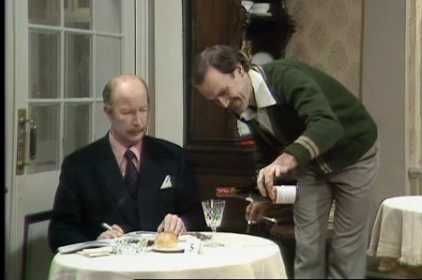MR WALT I’m afraid this is corked.
BASIL FAWLTY I just uncorked it. Didn’t you see me?
WALT What?
FAWLTY (shows him the cork on the end of the corkscrew) Look.
WALT No, no...
FAWLTY No, you see, I took it out of the bottle – that’s how I managed to get the wine out of the bottle and into your glass.
WALT I don’t mean that. I mean the wine is corked. The wine has reacted with the cork.
FAWLTY I’m sorry?
WALT The wine has reacted with the cork and gone bad.
Forty years on from this educational slice of sitcom, there can’t be many hoteliers left who would so misinterpret Mr Walt’s complaint. Even if the chemistry of 2,4,6-trichloroanisole and the precise nature of its deleterious effect remain specialist subjects, I’d like to think that the risk of a wine reacting with the cork and going bad is now fairly widely known.
Other wine faults, such as oxidation and Brettanomyces, are familiar to the vast majority of wine professionals as well as to many knowledgeable consumers, while there is arguably excessive awareness of re-fermentation in bottle, a problem often erroneously ascribed by some people to any wine with visible levels of natural carbon dioxide.
One fault, however, is more of a threat in certain kinds of wine than any of the above. Despite this, it is identified and discussed far more rarely, at least in my experience. The fault in question is termed, with appropriate menace, lightstrike.
Lightstrike occurs when a wine is exposed to blue and ultraviolet light, resulting in the transformation of amino acids into particularly stinky compounds such as dimethyl disulphide (DMDS for short). Fruit flavours become first tainted, then completely occluded by characters of overcooked cabbage, damp cardboard, and sewage.
The idea that light can damage wine is not new, informing as it does the standard advice that cellars should be kept dark, as well as the famous orange cellophane wrapping of Louis Roederer Cristal, bottled as it is in clear glass. Vintage port, the wine traditionally destined for the longest cellaring, is normally put into near-opaque brown bottles, the most effective at blocking damaging wavelengths.
The speed with which lightstrike occurs, however, is only now becoming appreciated. If the received wisdom implies that light degradation need concern only the well-heeled collector or the consumer of luxury champagne, the truth is far more serious.
Light can damage wine irreversibly in as little as one hour. It is therefore in shops, bars and restaurants, not cellars, where it is most likely to occur. Both sunlight and light from fluorescent bulbs include all the wavelengths responsible; some are also produced by LED and incandescent (traditional filament) lighting, resulting in a reduced but still potentially damaging effect.
Bottle colour has a huge influence on how much of this light reaches the wine itself, and the current trends are not helpful. Unfashionable amber glass blocks 90% or more of harmful light. Green glass blocks upwards of 50%, depending on hue, darkness and thickness. Clear glass can block as little as 10% of lightstrike wavelengths, but, despite this, is becoming ever more popular.
Clear glass’s increased popularity is directly related to the increase in sales of rosé, a style often enjoyed as much for its colour as for its taste, and hard to sell without putting that colour on display. Sparkling wine is particularly prone to lightstrike (the bubbles amplify the off aromas), so rosé fizz is arguably the most at-risk category, although it is more often found in coloured glass than its still counterparts are. But inexpensive white wine is increasingly appearing in clear glass bottles too. This trend is strongest in Italy – several of my suppliers there tell me that entry-level and mid-market white wines are now very tough to sell domestically in tinted bottles – but plenty of examples can be found from producers elsewhere.
A further trend is likely to contribute. Lightweight bottles are environmentally virtuous both at the point of production and during transport, but the thinner glass diminishes their light-blocking properties. While the glass can be treated to compensate for this loss of protection, it is unclear how many producers are doing this and whether the cost of so doing outweighs the financial and environmental savings of the lighter bottles. Nevertheless, even with standard bottles, lightstrike remains an ever-present risk. I struggle to think of another example of a product’s quality being so directly compromised by its packaging.
Most wine faults can be categorised as either batch or bottle problems. Cork taint is the latter: it affects individual bottles, sometimes even a few from a case, but almost never an entire production run. Other faults, particularly contamination or stability issues, will affect a whole batch. Lightstrike is peculiar in that it is neither – or potentially both. Since it only occurs once a wine is in bottle, but is capable of affecting all susceptible bottles equally, its presence is down to how those bottles are stored.
Clearly, days sitting on a brightly lit supermarket shelf are going to take their toll, but if the wine remains in its case until the last minute before being opened, surely it should be fine? Not necessarily. It may have been exposed to harmful light before it was boxed up at the winery. Before a newly filled bottle reaches the safe seclusion of darkness, there may be a gap, either if it is not labelled immediately, or perhaps a traditional-method sparkling wine needing to be disgorged, then labelled, then finally boxed up. Unless there are particular precautions taken, there is a chance the wine may be sitting about in a processing facility bathed in fluorescent light. I conjecture that this is why some bottles, especially fizz in clear glass, can be sent neatly boxed directly from the producer to, say, a wine competition, immediately bagged up for blind tasting, and still show the horrid, murky, cabbagey, compost-like aromas of lightstrike.
So much for the theory, though; the best thing you can do is experience the problem for yourself. This is lightstrike’s great advantage over other faults – it can be summoned at will! This will involve sacrificing a bottle, but you should only need to do this once, and it’s worth it for the knowledge you will gain. Try to obtain some decent sparkling rosé, in clear glass, that you know hasn’t been previously unboxed by its vendor. Put a bottle on your windowsill for, say, a week, then compare its aroma to a bottle straight from the case. The difference should be arresting.
I have fizz expert and wine writer Tom Stevenson to thank for presenting a slightly more elaborate version of this experiment at a conference I attended a few years ago. I was already a Master of Wine at this point, but under-versed in the practical effect of lightstrike. Tasting his prepared samples was a genuine revelation. I knew I had encountered those unpleasant flavours before, but never spotted the pattern of their underlying cause. Ever since, I know it when I smell it.
Unlike cork, which is controversial precisely because it presents real technical advantages as well as undesirable risks, clear glass bottles bring no benefit whatsoever to the wines they house. Their sole benefit is cosmetic, while their only effect on quality is to jeopardise it. Rosé risks tasting murky if left in clear glass, but always looks murky if bottled in mid-green, and from a commercial point of view, in this case the eyes have it. Producers who do stick to their green-glass guns are to be applauded.
This is not to say that you should immediately stop buying wines in clear bottles. Most will probably be fine. But it is worth paying extra attention to how they might have been stored before purchase, and where you keep them at home.
I confess that in my role as purchasing director for Berkmann Wine Cellars in London, I currently import over 100 wines bottled in clear glass, and I am aware of the apparent hypocrisy in doing so despite the in-built vulnerability. It is a commercial necessity that brings me unease, although they are stored with care and turn over quickly. I would therefore be delighted were popular demand to turn against clear glass, and this will only arise from awareness of the problem. So one final plea: if you happen to be in the middle of writing a hit TV series, please have a character send back a bottle of lightstruck wine.













